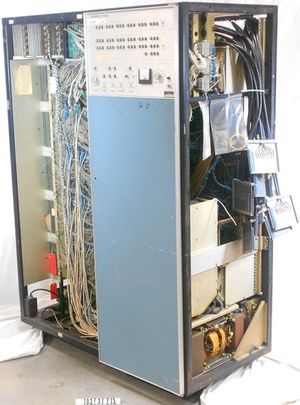Difference between revisions of "Fabritek Core Memory"
m |
m |
||
| Line 4: | Line 4: | ||
Former Fabri-Tek engineer Gary Andersen told this story: | Former Fabri-Tek engineer Gary Andersen told this story: | ||
| − | ''It was one of the first 1 MB add on memories, if not the first, built by a third party vendor. I gave a paper on the design at the Spring Joint Computer show in Manhattan in May of 1965. Dr. Marvin Minsky, from his artificial intelligence lab, [was in the audience]. Unshaven, in a white dress shirt hanging out in back, and in sock-less sandal shoes he came up to me and said, “I want one.” | + | ''It was one of the first 1 MB add on memories, if not the first, built by a third party vendor. I gave a paper on the design at the Spring Joint Computer show in Manhattan in May of 1965. Dr. Marvin Minsky, from his artificial intelligence lab, [was in the audience]. Unshaven, in a white dress shirt hanging out in back, and in sock-less sandal shoes he came up to me and said, “I want one.”'' |
| − | I said, all we have is a prototype. His response was, “I don’t care. Thanks. When you be in Boston again?” Two weeks later our sales guy and I negotiated a 1 MB add on for his DEC PDP6 computers, one of only 26 PDP6 computers made, for about $230,000 for a 5 microsecond cycle time memory that used 80m ferrite cores, plus another $5000 for every 1/2 microsecond better cycle time, I believe. He wrote the order number on the back of an envelope. | + | ''I said, all we have is a prototype. His response was, “I don’t care. Thanks. When you be in Boston again?” Two weeks later our sales guy and I negotiated a 1 MB add on for his DEC PDP6 computers, one of only 26 PDP6 computers made, for about $230,000 for a 5 microsecond cycle time memory that used 80m ferrite cores, plus another $5000 for every 1/2 microsecond better cycle time, I believe. He wrote the order number on the back of an envelope. '' |
| − | We didn’t believe it, but a week later a hard copy purchase order came from MIT. It was a real chore. Not only the memory, but also the interface. As I remember DEC wasn’t real cooperative. It was a long haul, but we finished and got paid $240,000, I believe'' | + | ''We didn’t believe it, but a week later a hard copy purchase order came from MIT. It was a real chore. Not only the memory, but also the interface. As I remember DEC wasn’t real cooperative. It was a long haul, but we finished and got paid $240,000, I believe'' |
== External links == | == External links == | ||
Revision as of 14:09, 8 January 2022
256K x 40 bit core memory.
Former Fabri-Tek engineer Gary Andersen told this story: It was one of the first 1 MB add on memories, if not the first, built by a third party vendor. I gave a paper on the design at the Spring Joint Computer show in Manhattan in May of 1965. Dr. Marvin Minsky, from his artificial intelligence lab, [was in the audience]. Unshaven, in a white dress shirt hanging out in back, and in sock-less sandal shoes he came up to me and said, “I want one.”
I said, all we have is a prototype. His response was, “I don’t care. Thanks. When you be in Boston again?” Two weeks later our sales guy and I negotiated a 1 MB add on for his DEC PDP6 computers, one of only 26 PDP6 computers made, for about $230,000 for a 5 microsecond cycle time memory that used 80m ferrite cores, plus another $5000 for every 1/2 microsecond better cycle time, I believe. He wrote the order number on the back of an envelope.
We didn’t believe it, but a week later a hard copy purchase order came from MIT. It was a real chore. Not only the memory, but also the interface. As I remember DEC wasn’t real cooperative. It was a long haul, but we finished and got paid $240,000, I believe
